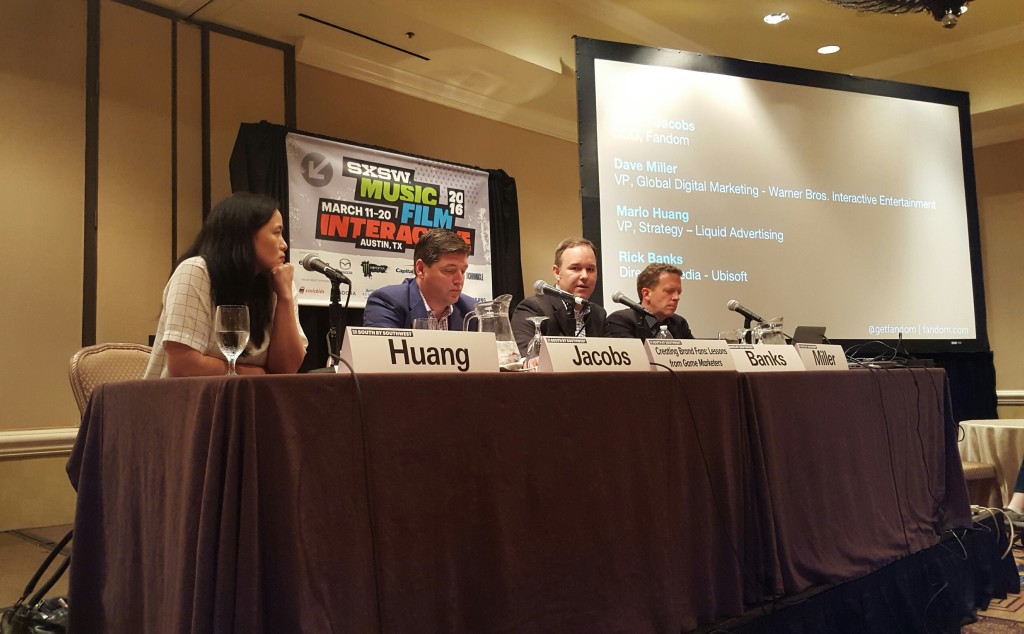Game fans may have noticed a difference in the way they hear and talk about games. More and more big name games come out with sort of theatrical trailers, much like those in the movies. There is a market now online, streaming game reviews, game tutorials and other discussions that revolve around gameplay.
Joining Walker Jacobs of Wikia Inc. was Director of Media at Ubisoft Rick Banks, VP of Global Marketing at Warner Brothers Dave Miller and VP of Strategy at Liquid Advertising Marlo Huang for the panel “Creating Brand Fans: Lessons from Game Marketers.”
The four have backgrounds in game marketing, which they all say has changed immensely in the past few years.
Games have the same sort of pressure as movies to sell, even more so. Huang says game advertising has many more limitations.
“A lot of the talent we hire actually comes from movies…but it’s different,” she said. “We don’t have the same source materials (movies have). We have far more limitations.”
While games have the same push to reach a certain amount of sales as movies, they only have a limited amount of theatrical material from cut scenes that drive the storyline. Integrating that with actual gameplay takes a lot more work.
It’s also harder to get people to buy a $60 game versus a $5 to $10 movie ticket.

“They research a product, ask their friends about it…that means you need a more intensive campaign,” Miller said.
“People ask us, do we spend the same as movie studios do? I usually tell them ‘Take a zero off the end and that’s about right,’” said Banks.
Miller said with a game approximately $8 million, the marketing budget might be about $3 million. Among other costs.
He said many games delay their release if they haven’t caused enough buzz. The good news, he said, is that it makes them even more thoughtful and strategic.
In order to engage fans, game marketers often turn to influencer marketing. They often find a person who posts on YouTube or Twitch to review their game and connect to the person’s followers.
Though Huang said she’s not a fan, the panel all agreed influencers are effective in reaching out to fans.
“Unless they have a clear idea of what they want and what the marketer wants to say…it can be a real time sink,” she said. “I think they’re effective but I think they’re a pain in the ass.”
Jacobs says it’s appealing because the fans feel like they have a sense of control and say in the market.
“The value of the influencers is like any celebrity – their fans like them for something very specific,” Miller said. “The trick is being comfortable enough to take your hands off your intellectual property and let them (be creative with it).”
With many longstanding brands, the community of fans tends to do its own publicity, whether it realizes it or not.
For something like Mortal Kombat, marketers can drop hints and let the fans create their own rumors and buzz around what will come next.
“I think (Mortal Kombat) is the oldest-running brand in the space,” Miller said. “That’s something where we think about the community first. It’s a very successful franchise. There’s intense loyalty to the original creator from the 90s.”
But game makers can’t just move on after a game has released, but must keep a relationship with the customers, so they become loyal to the brand, keep getting updates, and keep telling their friends about the game.
Game makers will also release extended content later, after the game has been released, though Miller says it’s a delicate balance of waiting. If they release it too soon, the consumer feels cheated, like they were cheated of material that should have been on the game. If they wait too long, the buzz will have died down and loses momentum, and no one will buy extended content.

“I think 2016 is the year where game publishers are going to figure out episodic and extended engagement on console,” said Miller. The shift would possibly mean shorter, more affordable games in more frequent release intervals.
Another hurdle with marketing is advertising online through “traditional online advertising,” they said, is that many gamers are tech savvy and often put up ad blockers extensively. Around 50 percent of their audience has an ad blocker, Huang said.
One more consideration has to do with selling at box stores versus online. Many more computer games are available online-only, but it’s mixed for console games.
While box stores are more hassle with manufacturing, packing, shipping, etc., they offer an opportunity for discovery. Consumers can stumble upon something they wouldn’t otherwise be interested in, and marketing can catch their attention with signage. They also cater to a younger audience – kids – who don’t have a credit card.
The panel also talked briefly about VR, which they said is an inevitable addition to gaming.
“My opinion was that this is going to go the way of the 3D TV. No one’s going to want to put on the goggles and stumble around their living room,” Banks said, but was very impressed once he tried VR. “That experience is extraordinarily hard to translate in any of our marketing media forms.”
